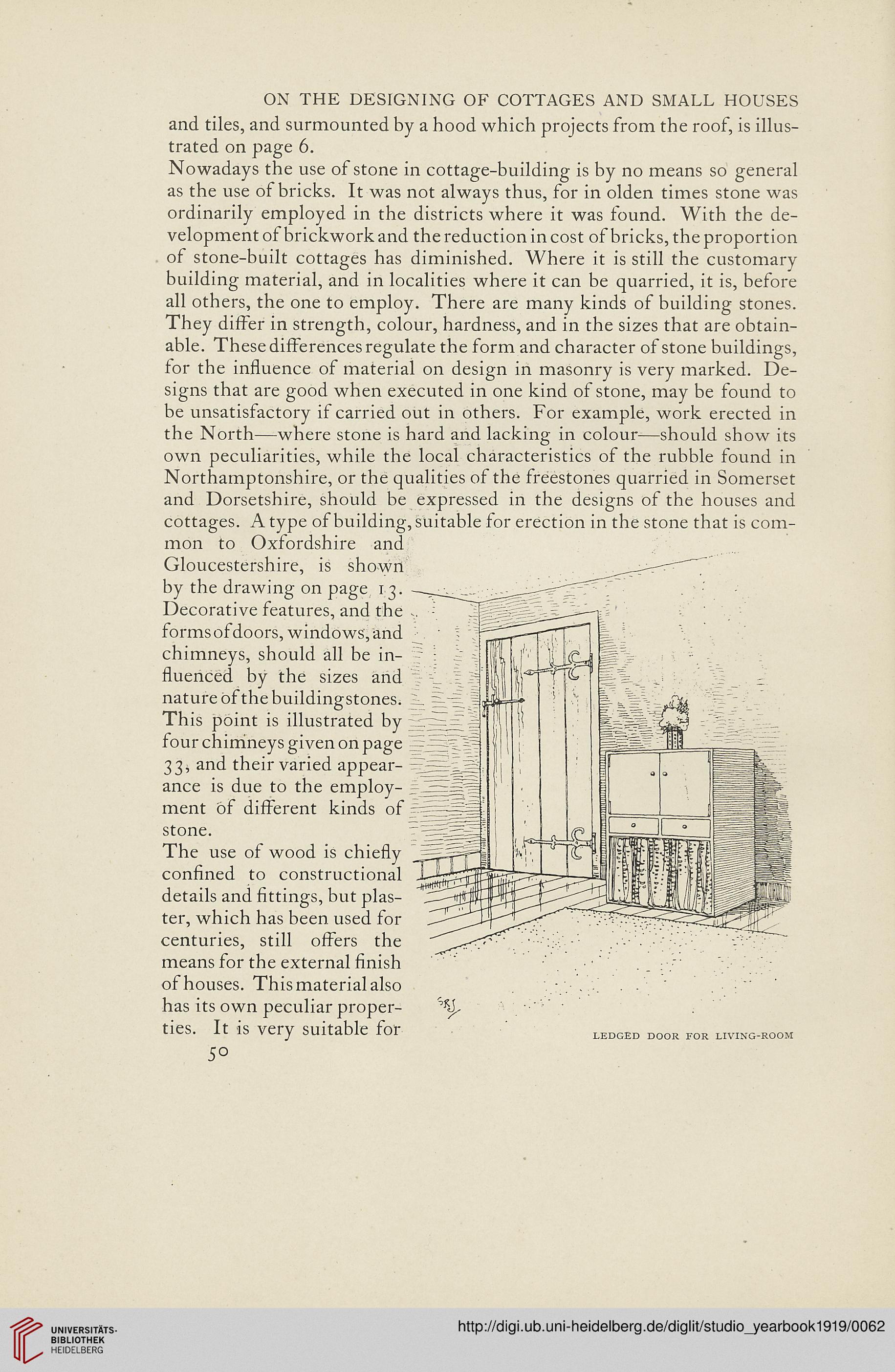ON THE DESIGNING OF COTTAGES AND SMALL HOUSES
and tiles, and surmounted by a hood which projects from the roof, is illus-
trated on page 6.
Nowadays the use of stone in cottage-building is by no means so general
as the use of bricks. It was not always thus, for in olden times stone was
ordinarily employed in the districts where it was found. With the de-
velopment of brickwork and the reduction in cost of bricks, the proportion
of stone-built cottages has diminished. Where it is still the customary
building material, and in localities where it can be quarried, it is, before
all others, the one to employ. There are many kinds of building stones.
They differ in strength, colour, hardness, and in the sizes that are obtain-
able. These differences regulate the form and character of stone buildings,
for the influence of material on design in masonry is very marked. De-
signs that are good when executed in one kind of stone, may be found to
be unsatisfactory if carried out in others. For example, work erected in
the North—where stone is hard and lacking in colour—should show its
own peculiarities, while the local characteristics of the rubble found in
Northamptonshire, or the qualities of the freestones quarried in Somerset
and Dorsetshire, should be expressed in the designs of the houses and
cottages. A type of building, suitable for erection in the stone that is com-
mon to Oxfordshire and
Gloucestershire, is shown
by the drawing on page i 3.
Decorative features, and the v
forms of doors, windows, and
chimneys, should all be in- y
fluenced by the sizes and
nature of the buildingstones. A
This point is illustrated by A
four chimneys given on page £-
33, and their varied appear-
ance is due to the employ- 5
ment of different kinds of -
stone.
The use of wood is chiefly
confined to constructional
details and fittings, but plas-
ter, which has been used for
centuries, still offers the
means for the external finish
of houses. This material also
has its own peculiar proper- ^
ties. It is very suitable for
5°
LEDGED DOOR FOR LIVING-ROOM
and tiles, and surmounted by a hood which projects from the roof, is illus-
trated on page 6.
Nowadays the use of stone in cottage-building is by no means so general
as the use of bricks. It was not always thus, for in olden times stone was
ordinarily employed in the districts where it was found. With the de-
velopment of brickwork and the reduction in cost of bricks, the proportion
of stone-built cottages has diminished. Where it is still the customary
building material, and in localities where it can be quarried, it is, before
all others, the one to employ. There are many kinds of building stones.
They differ in strength, colour, hardness, and in the sizes that are obtain-
able. These differences regulate the form and character of stone buildings,
for the influence of material on design in masonry is very marked. De-
signs that are good when executed in one kind of stone, may be found to
be unsatisfactory if carried out in others. For example, work erected in
the North—where stone is hard and lacking in colour—should show its
own peculiarities, while the local characteristics of the rubble found in
Northamptonshire, or the qualities of the freestones quarried in Somerset
and Dorsetshire, should be expressed in the designs of the houses and
cottages. A type of building, suitable for erection in the stone that is com-
mon to Oxfordshire and
Gloucestershire, is shown
by the drawing on page i 3.
Decorative features, and the v
forms of doors, windows, and
chimneys, should all be in- y
fluenced by the sizes and
nature of the buildingstones. A
This point is illustrated by A
four chimneys given on page £-
33, and their varied appear-
ance is due to the employ- 5
ment of different kinds of -
stone.
The use of wood is chiefly
confined to constructional
details and fittings, but plas-
ter, which has been used for
centuries, still offers the
means for the external finish
of houses. This material also
has its own peculiar proper- ^
ties. It is very suitable for
5°
LEDGED DOOR FOR LIVING-ROOM




